Neumz is the only complete recording of all Gregorian Chant in the world. More than 7000 hours in an App for iOS and Android
 The entire Gregorian chant repertory, including both Novus Ordo and Vetus Ordo, as recorded by the communities of Benedictine nuns of the Abbey of Notre-Dame de Fidélité of Jouques and the Benedictine monks of Abbaye Sainte-Madeleine du Barroux in French Provence.
The entire Gregorian chant repertory, including both Novus Ordo and Vetus Ordo, as recorded by the communities of Benedictine nuns of the Abbey of Notre-Dame de Fidélité of Jouques and the Benedictine monks of Abbaye Sainte-Madeleine du Barroux in French Provence.
 Each chant is synchronised with its square-note scores, accompanied by the neumatic notations of St. Gall and Laon, Latin texts, and its translation into the user’s language.
Each chant is synchronised with its square-note scores, accompanied by the neumatic notations of St. Gall and Laon, Latin texts, and its translation into the user’s language.
 Neumz is the first and only complete recording and the first complete digital resource for liturgical materials. The contents of the Psalter, Lectionary, Collectary, Antiphonary, Responsoriary, and Gradual are assembled into a 21st-century multimedia “Liber Digitalis” chant book.
Neumz is the first and only complete recording and the first complete digital resource for liturgical materials. The contents of the Psalter, Lectionary, Collectary, Antiphonary, Responsoriary, and Gradual are assembled into a 21st-century multimedia “Liber Digitalis” chant book.
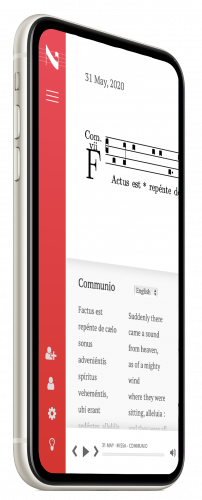
 First-morning prayer (Ad Matutinum)
First-morning prayer (Ad Matutinum)
 Lauds (Ad Laudes)
Lauds (Ad Laudes)
 Prime (Vetus Ordo only)
Prime (Vetus Ordo only)
 Minor Hours (Ad Tertiam, Ad Sextam and Ad Nonam)
Minor Hours (Ad Tertiam, Ad Sextam and Ad Nonam)
 Vespers (Ad Vesperas)
Vespers (Ad Vesperas)
 Compline (Ad Completorium)
Compline (Ad Completorium)
 All variants of the Ordinary chants
All variants of the Ordinary chants
 Propers of the three-year Novus Ordo cycle
Propers of the three-year Novus Ordo cycle
 Votive Masses
Votive Masses
Neumz presents the Liturgical Calendar in an easy-to-use, solar calendar. We recalculate the Liturgical Order every year, so you do not have to.
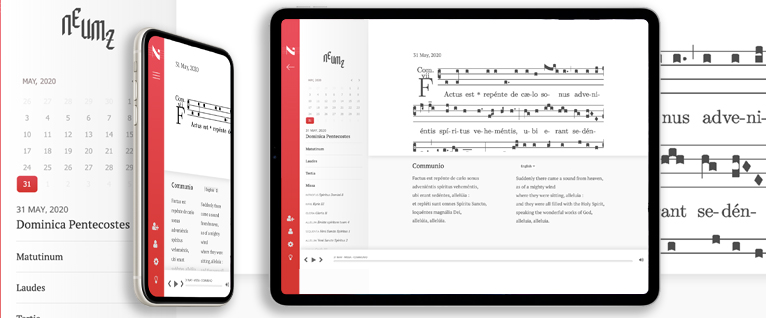
Complete daily audio recordings of the Sisters of Notre-Dame de Fidélité de Jouques and the monks of Sainte-Madeleine du Barroux in high fidelity.
Follow along with each chant’s square note score, which scrolls with the music.
Facing page Latin to localised translations, currently available in English, Spanish, French, and Italian.
Create a free account here or through the Android and Apple apps to listen to the chants of the hour.
Listen to what you want.
Save and bill annually.
Get two months free!
Two-thirds of the revenues from subscriptions will go to the monastic communities. Your support helps make Neumz a better tool to unite the world in the common prayer of the Church, as well as directly aiding the Sisters in Jouques, their foundation in Benin, and the monks in Le Barroux.
Navigate day by day using the normal solar calendar.
Control your account, upgrade to Patron to access Play on Demand.
Toggle Night Mode: it darkens your screen.
Settings. Change language, rite, score type, notification settings, and manage downloads.
Neumz is the largest recording project ever undertaken.
The community of forty-five nuns at the Abbey of Jouques and the fifty-three monks of the Abbay Sainte-Madeleine du Barroux live withdrawn from the bustle of modern life, in communion with nature and in quiet contemplation. Their life is regularized by the rhythm of ora et labora, prayer and work, the centerpiece of the Rule of St. Benedict. Their days are divided by the regular Offices of the Liturgy of the Hours and include daily Mass.
Their years follow the Earth’s seasons and the Liturgical Calendar, a cycle of feast days that celebrate the Church’s Saints through which they meditate on Holy Scripture. The complete Novus Ordo liturgy covers three years of recordings. It presents the entire Gregorian repertoire, including thousands of pieces (the equivalent of more than 7000 CDs). The complete Vetus Ordo cycle lasts one year, and will add well over two-thousand hours of chants.

In the course of Repertorium, the Neumz team is also responsible for the digitisation of the Solesmes archive and is helping to create AI tools to help study, transcribe, and identify previously uncatalogued chants. The entire archive will be publicly available through the University of Oxford’sDigital Image Archive of Medieval Music (DIAMM). A selection of rediscovered novel chants, perhaps unsung for over a millennium, will be added to Neumz in 2025.


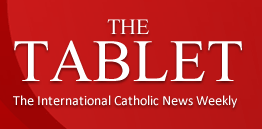
The Abbey of Notre-Dame de Fidélité is a monastery of Benedictine nuns located in Jouques, near Aix-en-Provence. Founded in 1967 by the nuns from the Abbey of Saint-Louis du Temple of Limon, the convent became an autonomous priory in 1970, becoming an abbey in 1981. The growth of the community allowed them to found the abbey Notre-Dame de Miséricorde in Rosans in the diocese of Gap in 1991, and then the monastery Notre-Dame de l’Écoute in Benin (Pèporiyakou, diocese of Natitingou) in 2005. The third abbess of Jouques, Mother Marie Monique Guttin, was elected on August 3, 2017. As of 2020, the community in Jouques includes forty-five sisters aged 26 to 85. For more info, please visit www.abbayedejouques.org
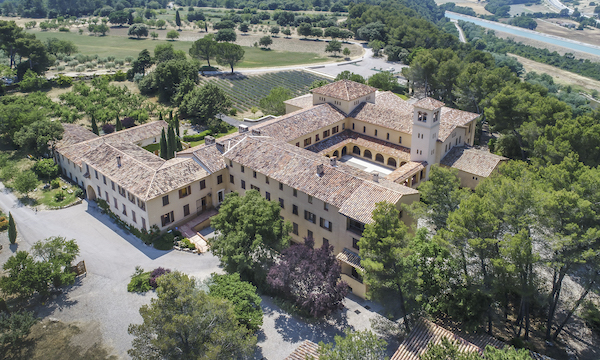
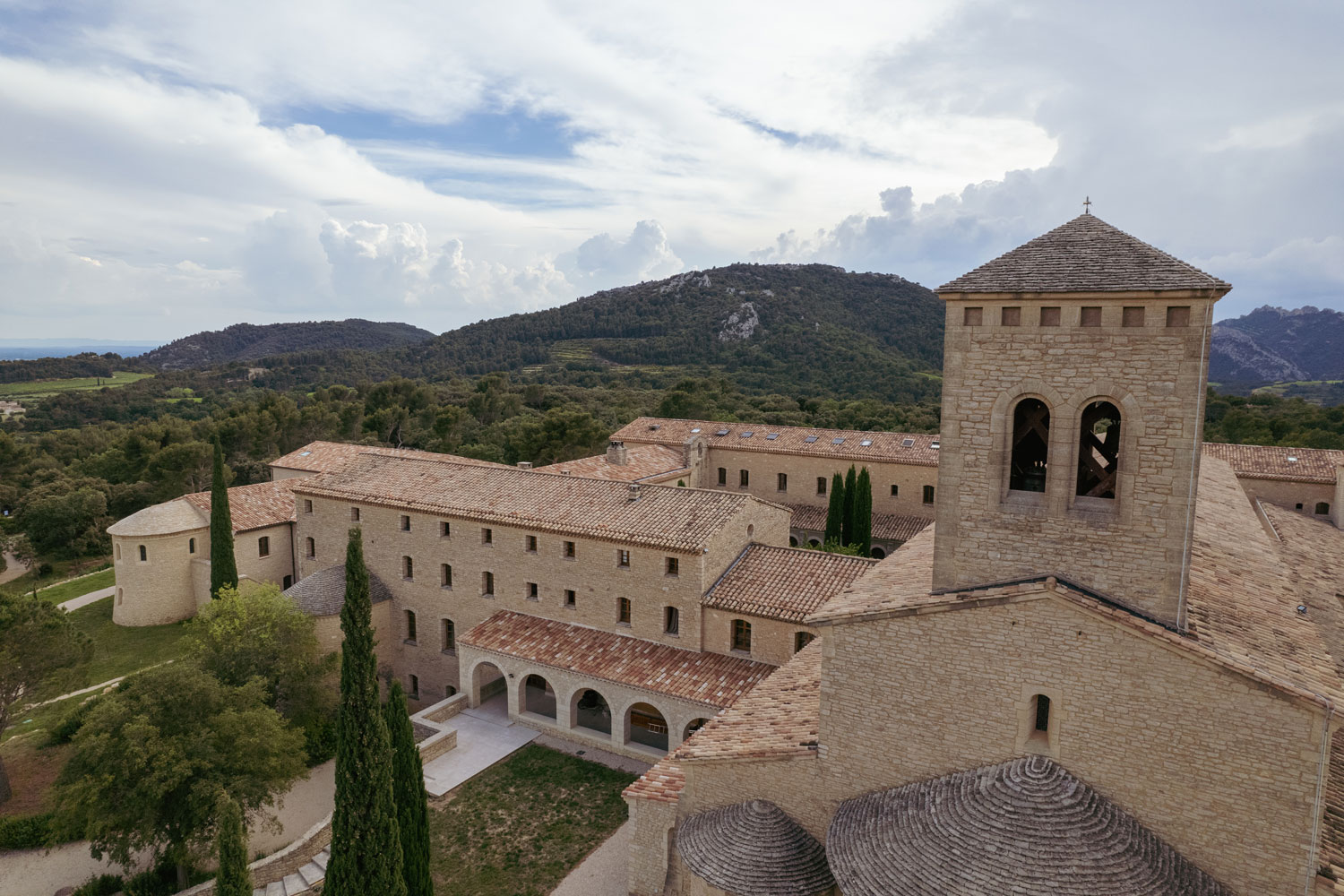
The Abbey of Sainte-Madeleine is a Catholic Benedictine monastery of traditionalist sensibility, located in Le Barroux, Vaucluse, France; it was founded in 1970 by Dom Gérard Calvet (+2008), in the former priory of La Madeleine (11th c.) in Bédoin, at the foot of Mont Ventoux, before the construction of the current abbey in Le Barroux and the consecration of the church in 1989 by Cardinal Gagnon. It is currently led by Dom Louis-Marie de Geyer d’Orth and has 58 monks. The abbey follows the pre-1969 Roman Missal (Tridentine Mass) and has been broadcasting its daily Divine Office online since several years. In 2002, eight monks were sent to found a new community at Saint-Pierre-de-Clairac, near Agen (Lot-et-Garonne), the Monastery of Sainte-Marie de la Garde, which has since been elevated to abbey status and currently numbers 19 monks. For more info, please visit www.barroux.org
The Greatest Love Song Ever Recorded
Sung for over 1000 years without interruption
Gregorian chant is the chant of the Western Church.
Its origins date to the 8th century, and it quickly spread throughout Europe. The Benedictine Order adopted it as its Chant repertory for its liturgy and has cultivated it ever since. Neumes, in Latin neuma, are signs that represent one or more sounds in notation.
The monastic day, which follows the rhythm of the Sun, bases itself on Psalm 113, A solis ortu usque ad occasum laudabile nomen Domini,
“from the rising of the sun to its going down,
The Lord’s name is to be praised.”
The whole day is centered around the Mass, which is its central axis, and is punctuated by hours of prayer from the Divine Office, also called the Liturgy of the Hours.

In his Rule, Saint Benedict provides for a balanced division to the monk’s day, shared between the prayer of the Office – or prayer of the Hours, designated according to the progress of the course of the sun – and Lectio Divina, manual or intellectual work, and rest.
Unlike the Mass repertoire, the Divine Office is essentially composed of Antiphons (a sort of refrain) that introduce and conclude the recitation of the Psalms, as well as Responses (which can be more or less ornate), Readings, Hymns, and opening and closing Prayers. Saint Benedict stipulated in his Rule that the monks sing the entire Psalter, the book of Psalms, every week, and this has been done since the 6th century.
Neumz offers the possibility of listening to the canonical hours of the first morning prayer (Ad Matutinum), followed by lauds (Ad Laudes), passing through the so-called minor hours (Prime [Vetus Ordo only], Third, Sixth and Ninth) until arriving in the evening at the song of Vespers (Ad Vesperas), to end the day with the prayer of Compline (Ad Completorium).
Canonical hours or Offices represent the division of the Christian day, with fixed prayers said or sung at particular times. They are sometimes referred to as the Canonic hours of the monastic office, the Liturgy of the Hours, or the Divine Office. A Book of Hours contains a selection of these prayers, often elaborately decorated. The roots of this practice were formalised in the 8th century, and in the 11th century, the followers of the Order of St Benedict further reformed the hours to reflect the liturgy.
The Gregorian chant used to sing the offices will usually involve Antiphons based on Psalms, with more complex Great Responsories sung at Matins, contrasting with the simpler Short Responsories of the Lesser Hours and Compline.
At the end of the Office, one of four Marian antiphons is sung: Alma Redemptoris Mater, Ave Regina caelorum, Regina caeli laetare, or Salve, Regina. These are relatively late chants, dating from the 11th century, and are richer and more complex than most Office antiphons.
Neumz offers all the parts,
sung, chanted, or recited
in Latin of the Mass and the Office.
Thus, for the Mass, the songs of the Ordinary (Kyrie, Gloria, Credo, Sanctus, and Agnus Dei) and of each day’s Propers (Introitus, Graduale, Tractus, Alleluja, Offertorium and Communio) can be heard according to the liturgical cycle.
The Mass is the main form of worship in the Roman Catholic Church, and is divided into two main parts: the liturgy of the Word, which includes Biblical readings and often a sermon, and the liturgy of the Eucharist, culminating in the sacrament of Holy Communion.
The word ‘mass’ comes from the Latin ‘missa’ used at the end of the service to dismiss the congregation: Ite, missa est. The word ‘Catholic’ means ‘universal’, and the idea behind the Latin Mass was to worship in one universal language that could be understood by anyone in any part of the world. Following the Second Vatican Council of the 1960s, it became more common for the Mass to be said in the vernacular.
In the tradition of Gregorian plainchant, all sections of the Mass may be sung, including the Proper of the Mass. Many of the most intricate and complex Gregorian chants are found in parts of the Mass with shorter, repeating texts such as the Kyrie and the Agnus Dei; in expansive texts such as the Gloria and the Credo; and in Offertories, some of the oldest examples of which are particularly ornate.
Also referred to as the “Novus Ordo”, or the “Mass of Paul VI”.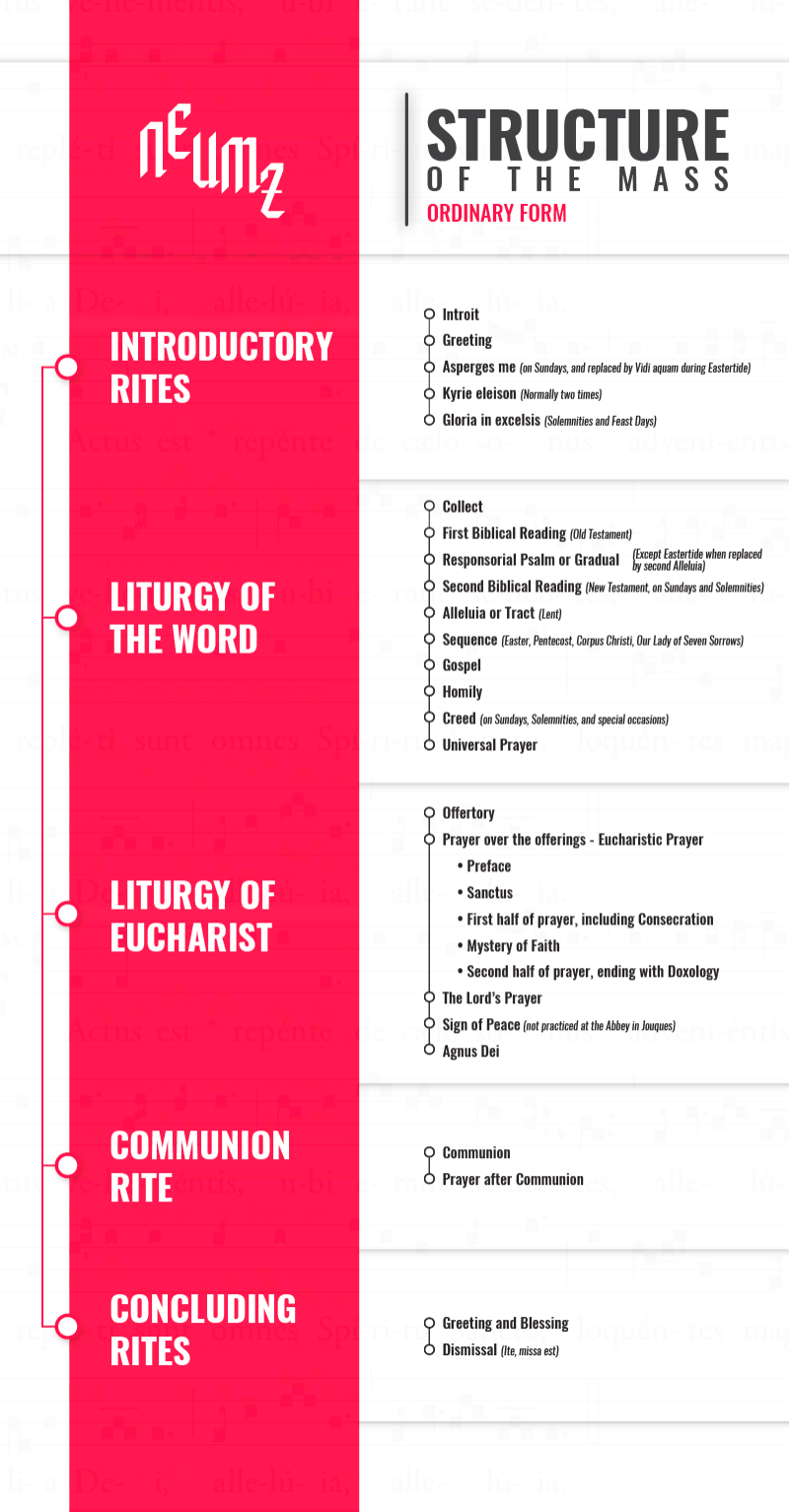
Also referred to as the “Vetus Ordo”, “Traditional Rite”, “Tridentine Mass”, “Traditional Latin Mass”, or “Mass of Saint Pius V”.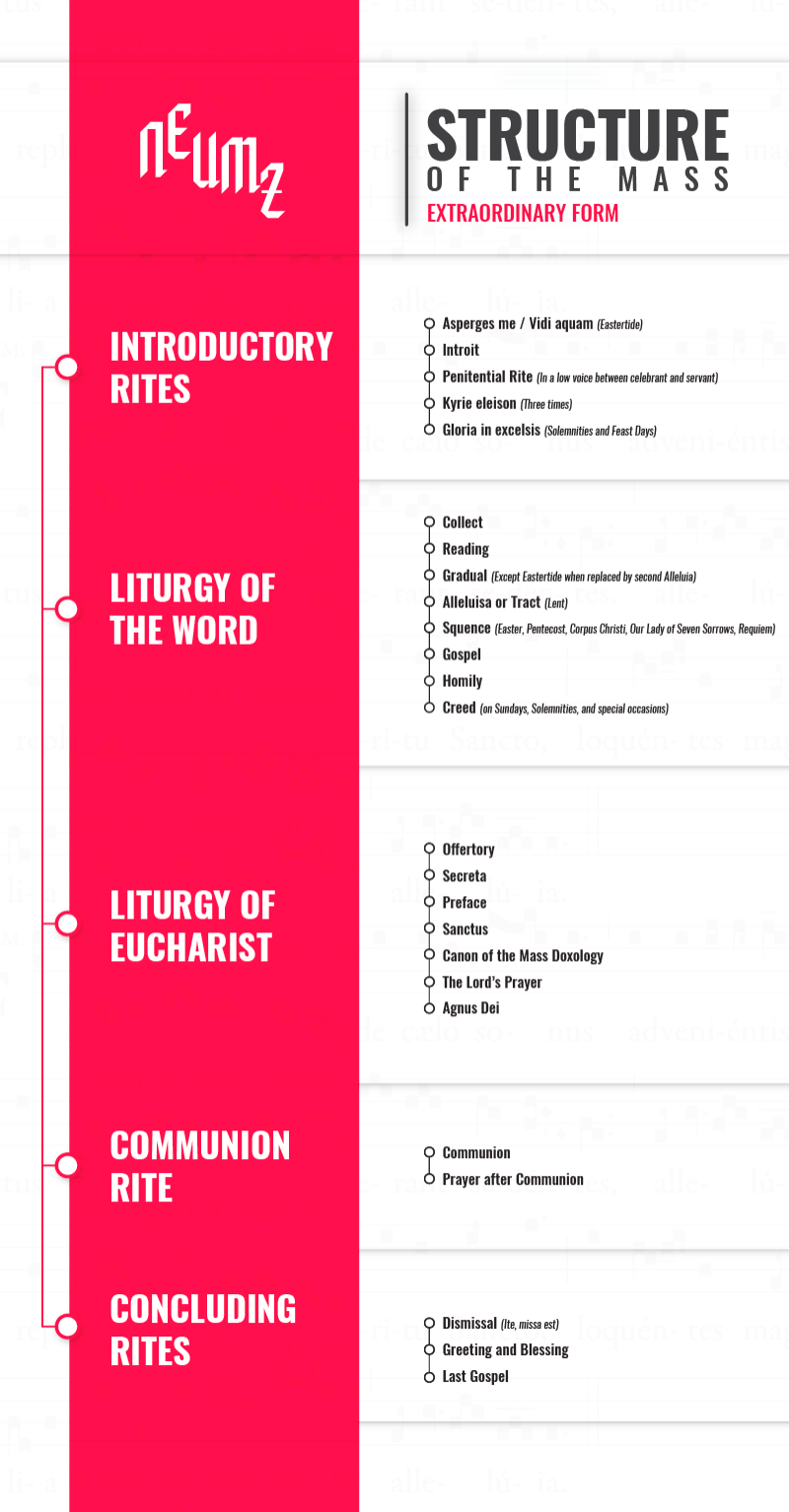
The Ordinary of the Mass varies very little regardless of the liturgical context or season, and consists of five main sections, often used in musical Mass settings: the Kyrie, Gloria, Credo, Sanctus and Agnus Dei.
The Proper of the Mass encompasses other sections that may vary according to the liturgical context or time of year, including the Introit, Graduale, Alleluia (except Lent), Tract (Lent), Offertory and Communion.
| Lent, Liturgy and Gregorian Chant by Catherine Restrepo |
History of Gregorian Chant A short introduction |
| How to read Square Note Notation Infographic |
Other Chants – Western and Eastern Traditions Catholic Rites and Variations |
Please read our Latest News